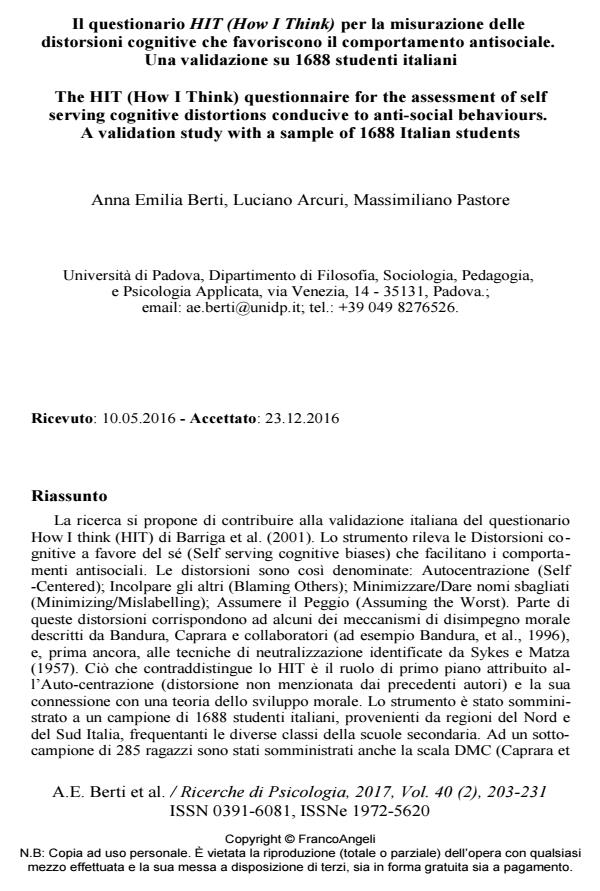Il questionario HIT (How I Think) per la misurazione delle distorsioni cognitive che favoriscono il comportamento antisociale. Una validazione su 1688 studenti italiani
Titolo Rivista RICERCHE DI PSICOLOGIA
Autori/Curatori Anna Emilia Berti, Luciano Arcuri, Massimiliano Pastore
Anno di pubblicazione 2017 Fascicolo 2017/2
Lingua Italiano Numero pagine 29 P. 203-231 Dimensione file 350 KB
DOI 10.3280/RIP2017-002003
Il DOI è il codice a barre della proprietà intellettuale: per saperne di più
clicca qui
Qui sotto puoi vedere in anteprima la prima pagina di questo articolo.
Se questo articolo ti interessa, lo puoi acquistare (e scaricare in formato pdf) seguendo le facili indicazioni per acquistare il download credit. Acquista Download Credits per scaricare questo Articolo in formato PDF

FrancoAngeli è membro della Publishers International Linking Association, Inc (PILA)associazione indipendente e non profit per facilitare (attraverso i servizi tecnologici implementati da CrossRef.org) l’accesso degli studiosi ai contenuti digitali nelle pubblicazioni professionali e scientifiche
La ricerca si propone di contribuire alla validazione italiana del questionario How I think (HIT) di Barriga et al. (2001). Lo strumento rileva le Distorsioni cognitive a favore del sé (Self serving cognitive biases) che facilitano i comportamenti antisociali. Le distorsioni sono così denominate: Autocentrazione (Self -Centered); Incolpare gli altri (Blaming Others); Minimizzare/Dare nomi sbagliati (Minimizing/Mislabelling); Assumere il Peggio (Assuming the Worst). Parte di queste distorsioni corrispondono ad alcuni dei meccanismi di disimpegno morale descritti da Bandura, Caprara e collaboratori (ad esempio Bandura, et al., 1996), e, prima ancora, alle tecniche di neutralizzazione identificate da Sykes e Matza (1957). Ciò che contraddistingue lo HIT è il ruolo di primo piano attribuito all’Autocentrazione (distorsione non menzionata dai precedenti autori) e la sua connessione con una teoria dello sviluppo morale. Lo strumento è stato somministrato a un campione di 1688 studenti italiani, provenienti da regioni del Nord e del Sud Italia, frequentanti le diverse classi della scuole secondaria. Ad un sottocampione di 285 ragazzi sono stati somministrati anche la scala DMC (Caprara et al., 2006) e il questionario sui valori di Schwartz (1992). Ad un sottocampione di 587 ragazzi, di I, III, e V sono state somministrate la scala sulla disapprovazione della devianza e quella sulla devianza dichiarata, contenute nel questionario "Io e la mia salute" (Bonino et al., 2003). L’analisi fattoriale confermativa ha identificato i fattori corrispondenti alle quattro distorsioni. La validità convergente dello strumento è stata confermata dalle elevate correlazioni positive tra i punteggi fattoriali corrispondenti alle quattro distorsioni cognitive e lo DMC (0,68 < r < 0,70) i comportamenti devianti dichiarati (0,58 < r < 0,59) e dalla correlazione negativa con la disapprovazione dei comportamenti devianti (-0,58 < r < -0,68). Per quanto riguarda i valori, sono emerse correlazioni positive con potere (0,35 < r < 0,40), edonismo (0,28 < r < 0,31) stimolazione (0,27 < r < 0,31) e successo (0,15 < r < 0,17) e negative con benevolenza (-0,18 < r < -0,20) e universalismo (tutti gli r = -0,20), conformismo (-0,21 < r < -0,28) e spiritualità (-0,16 < r < -0,17). Un’interessante relazione curvilinea tra l’età dei partecipanti e le prestazioni nelle diverse scale dei comportamenti antisociali viene infine descritta e interpretata.
Parole chiave:Validazione questionario, distorsioni cognitive al servizio del sé, comportamento antisociale, studenti secondaria di secondo grado, analisi fattoriale confermativa.
- Emotional and cognitive correlates of hating among adolescents: An exploratory study Ugo Pace, Alessia Passanisi, Giulio D'Urso, in Journal of Adolescence /2018 pp.159
DOI: 10.1016/j.adolescence.2018.08.002 - Hating Adolescents Test (HAT): a preliminary development of a measure to assess hating among adolescents Ugo Pace, Giulio D’Urso, Carla Zappulla, in Psychiatry, Psychology and Law /2020 pp.234
DOI: 10.1080/13218719.2020.1719374
Anna Emilia Berti, Luciano Arcuri, Massimiliano Pastore, Il questionario HIT (How I Think) per la misurazione delle distorsioni cognitive che favoriscono il comportamento antisociale. Una validazione su 1688 studenti italiani in "RICERCHE DI PSICOLOGIA " 2/2017, pp 203-231, DOI: 10.3280/RIP2017-002003